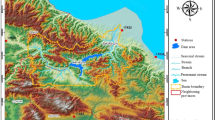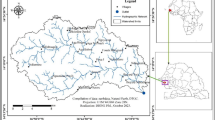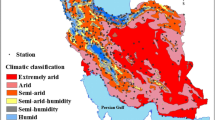Abstract
Given the limited fresh water resources available, evaporation from dam reservoirs and freshwater lakes whereby large amounts of water resources are lost is now becoming a serious challenge in hydrology and water resource management. In this study, Kohli and Frenken (KF) method and the KF modified (MKF) (for the modification of this method, level I (250 m) reference evapotranspiration (RET) data were obtained from the FAO’s WaPOR Product (FWP) which is a ready product based on remote sensing (RS)) were utilized to estimate reservoir evaporation (RE) in seventeen stations in Iran for the period of 9 years: 2009–2018. The current study includes four distinct steps, as follows. In the first step, the KF method was evaluated with the ground data (measured), and the ready RS product was then validated in the second step. In the third step, we evaluated the MKF method. Finally, in the fourth step, a number of statistical indices were evaluated for each of the methods in order to examine its performance. The results indicated that there was no significant difference between the estimated evaporation values using KF method and the measured values based on the statistical indices. As such, the validation of the ready RS product was acceptable for all dam reservoirs. Moreover, it was found that coefficients of the MKF equation for all stations had a relatively high degree of reliability (R〉0.871). Also, these coefficients had a wide range of variations in different regions, so using a fixed coefficient for all stations will have a relatively large error. The findings also revealed that using the MKF method can improve the performance of the KF method from 0.11 to 9.28%.








Similar content being viewed by others
References
Allen RG, Pereira LS, Raes D, Smith M (1998) Crop evapotranspiration—guidelines for computing crop water requirements – FAO Irrigation and Drainage Paper 56. FAO, Rome, Italy
Bastiaanssen W, Cheema M, Immerzeel W, Miltenburg I, Pelgrum H (2012) Surface energy balance and actual evapotranspiration of the transboundary Indus Basin estimated from satellite measurements and the ETLook model. Water Resour. Res. 48:100–120. https://doi.org/10.1029/2011wr010482
FAO (2015) FAOSTAT. Food and Agriculture Organization of the United Nations. Rome, Italy
FAO, 2017. WaPOR Database Methodology: Level 1 (beta release).
French AN, Hunsaker DJ, Thorp KR (2015) Remote sensing of evapotranspiration over cotton using the TSEB and METRIC energy balance models. Remote Sens Environ. 158:281–294. https://doi.org/10.1016/j.rse.2014.11.003
Golabi MR, Farzi S, Khodabakhshi F, Sohrabi Geshnigani F, Nazdane F, Radmanesh F (2020) Biochemical oxygen demand prediction: development of hybrid wavelet-random forest and M5 model tree approach using feature selection algorithms. Environ Sci Pollut Res. 27:34322–34336. https://doi.org/10.1007/s11356-020-09457-x
Guerschman JP, Van Dijk AIJM, Mattersdorf G, Beringer J et al (2009) Scaling of potential evapotranspiration with MODIS data reproduces flux observations and catchment water balance observations across Australia. J Hydrol. 369(1-2):107–119. https://doi.org/10.1016/j.jhydrol.2009.02.013
Hamon WR (1961) Estimating potential evapotranspiration. J. Hydraul. Div. 87:107–120
Harwell GR (2012) Estimation of evaporation from open water—a review of selected studies, summary of US army corps of engineers data collection and methods, and evaluation of two methods for estimation of evaporation from five reservoirs in Texas, Rep 2328-0328. (US Geological Survey)
Hassan M (2013) Evaporation estimation for Lake Nasser based on remote sensing technology. Ain Shams Eng J. 4(4):593–604. https://doi.org/10.1016/j.asej.2013.01.004
Hassan A, Ismail SS, Elmoustafa A, Khalaf S (2018) Evaluating evaporation rate from high Aswan Dam reservoir using RS and GIS techniques. Egypt. J. Remote Sens. Space Sci. 21:285–293. https://doi.org/10.1016/j.ejrs.2017.10.001
Hogeboom RJ, Knook L, Hoekstra AY (2017) The blue water footprint of the world's artificial reservoirs for hydroelectricity, irrigation, residential and industrial water supply, flood protection, fishing and recreation. Adv. Water Resour. 113:285–294. https://doi.org/10.1016/j.advwatres.2018.01.028
Irmak S, Haman D, Jones J (2002) Evaluation of class A pan coefficient for estimating reference evapotranspiration in humid location. J Irrig Drain Eng. 128(3):153–159. https://doi.org/10.1061/(ASCE)0733-9437(2002)128:3(153)
Javadian M, Behrangi A, Gholizadeh M, Tajrishy M (2019) METRIC and WaPOR Estimates of Evapotranspiration over the Lake Urmia Basin: comparative analysis and composite assessment. Water. 11(8):1647. https://doi.org/10.3390/w11081647
Jensen ME, Haise HR (1963) Estimating evapotranspiration from solar radiation. J. Irrig. Drain. Div. 89(4):15–41
Jia L, ** G, Liu S, Huang C, Yan Y, Liu G (2009) Regional estimation of daily to annual regional evapotranspiration with MODIS data in the Yellow River Delta wetland. Hydrol. Earth Syst. Sci. 13:1775–1787. https://doi.org/10.5194/hess-13-1775-2009
Knipper KR, Kustas WP, Anderson MC, Alfieri JG, Prueger JH, Hain CR, Gao F, Yang Y, McKee LG, Nieto H, Hipps LE, Alsina MM, Sanchez L (2018) Evapotranspiration estimates derived using thermal-based satellite remote sensing and data fusion for irrigation management in California vineyards. Irrig. Sci. 37:431–449. https://doi.org/10.1007/s00271-018-0591-y
Kohler MA, Nordenson TJ, Fox WE (1955) Evaporation from Pans and Lakes. U.S. Department of Commerce - Weather Bureau, Washington
Kohli A, Frenken K (2015) Evaporation from artificial lakes and reservoirs. FAO - AQUASTAT, Rome, p 10
Liaqat UW, Choi M (2017) Accuracy comparison of remotely sensed evapotranspiration products and their associated water stress footprints under different land cover types in Korean peninsula. J CLEAN PROD. 155:93–104. https://doi.org/10.1016/j.jclepro.2016.09.022
Melesse A, Abtew W, Dessalegne T (2009) Evaporation estimation of Rift Valley lakes: comparison of models. Sensors. 9(12):9603–9615. https://doi.org/10.3390/s91209603
Mhawej M, Fadel A, Faour G (2020) Evaporation rates in a vital lake: a 34-year assessment for the Karaoun Lake. Int. J. Remote Sens. 41(14):5321–5337. https://doi.org/10.1080/01431161.2020.1739354
Nash JE, Sutcliffe JV (1970) River flow forecasting through conceptual models I: a discussion of principles. J Hydrol. 10:282–290. https://doi.org/10.1016/0022-1694(70)90255-6
Nouri H, Beecham S, Anderson S, Hassanli AM, Kazemi F (2014) Remote sensing techniques for predicting evapotranspiration from mixed vegetated surfaces. Urban Water J. 12(5):380–393. https://doi.org/10.1080/1573062x.2014.900092
Palombelli A (2017) Development of functionalities for improved storage modelling in OSeMOSYS. MSc, Polytechnic University of Milan.
Palombelli A, Francesco G, Vincenzo RM, Mark H, Emanuela C (2020) Development of functionalities for improved storage modelling in OSeMOSYS. Energy. 117025:117025. https://doi.org/10.1016/j.energy.2020.117025
Papadavid G, Hadjimitsis DG, Toulios L, Michaelides S (2013) A modified SEBAL modeling approach for estimating crop evapotranspiration in semi-arid conditions. Water Resour Manag. 27:3493–3506. https://doi.org/10.1007/s11269-013-0360-x
Radmanesh F, Golabi MR, Khodabakhshi F, Farzi S, Zeinali M (2020) Modeling aquifer hydrograph: performance review of conceptual MODFLOW and simulator models. Arab J Geosci. 13:240. https://doi.org/10.1007/s12517-020-5230-2
Reyes-González A, Kjaersgaard J, Trooien T, Hay C, Ahiablame L (2018) Estimation of crop evapotranspiration using satellite remote sensing-based vegetation index. Adv Meteorol. 2018:4525021–4525012. https://doi.org/10.1155/2018/4525021
Stets EG, Striegl RG, Aiken GR, Rosenberry DO, Winter TC (2009) Hydrologic support of carbon dioxide flux revealed by whole lake carbon budgets. J. Geophys. Res. 114:G01008. https://doi.org/10.1029/2008JG000783
Sudheer KP (2000) Modeling hydrological processes using neural computing technique. PhD thesis, Indian institute of Technology, Dehli
Swelam A, Govind A, Abdallah M, Steduto P, Taha A (2019) Validation of remote-sensing evapotranspiration data of selected crops in the Nile delta. 3rd World Irrigation Forum (WIF3), Bali, Indonesia
Tantawy I, Timmermans J, Mohamed Y, Giesen NVD (2018) The application of the FAO Water Productivity Open-Access Portal (WaPOR) for the assessment of the Water-Energy-Food Nexus in the Eastern Nile River Basin. 20th EGU General Assembly, Vienna, Austria, p.5356.
Teshite TB (2018) Validation of fao-frame remote sensing based agricultural water productivity estimates in the upper Awash River basin, Ethiopia. MSc, University of Twente
Zhao G, Gao H (2019) Estimating reservoir evaporation losses for the United States: Fusing remote sensing and modeling approaches. Remote Sens. Environ. 226:109–124. https://doi.org/10.1016/j.rse.2019.03.015
Author information
Authors and Affiliations
Corresponding author
Additional information
Responsible Editor: Broder J. Merkel
Rights and permissions
About this article
Cite this article
Golabi, M.R., Niksokhan, M.H. & Radmanesh, F. Estimating reservoir evaporation: fusing Kohli and Frenken method and the FAO’s WaPOR Product. Arab J Geosci 13, 992 (2020). https://doi.org/10.1007/s12517-020-06023-0
Received:
Accepted:
Published:
DOI: https://doi.org/10.1007/s12517-020-06023-0




